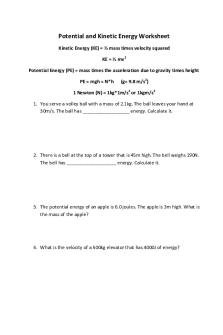Temperature as a Measure of Kinetic Energy PDF

| Title | Temperature as a Measure of Kinetic Energy |
|---|---|
| Author | Mavy Castillo |
| Course | Experimental Physics |
| Institution | Carnegie Mellon University |
| Pages | 2 |
| File Size | 44.9 KB |
| File Type | |
| Total Downloads | 58 |
| Total Views | 150 |
Summary
Sir Alex...
Description
Lecture Topic: Temperature as a Measure of Kinetic Energy It is at this point that we can use a more sophisticated definition of temperature. Temperature is a measure of the average kinetic energy of the particles within a sample of matter. Kinetic energy was defined as the energy of motion. An object or a particle “that is moving has kinetic energy. There are three common forms of kinetic energy - vibrational kinetic energy, rotational kinetic energy and translational kinetic energy. This is referred to as translational kinetic energy. A ball moving through space has translational kinetic energy. But an object can also have vibrational kinetic energy; this is the energy of motion possessed by an object that is oscillating or vibrating about a fixed position. And a mass attached to a spring has vibrational kinetic energy. Such a mass is not permanently displaced from its position like a ball moving through space. Finally, an object can have rotational kinetic energy; this is the energy associated with an object that is rotating about an imaginary axis of rotation. A spinning top isn't moving through space and isn't vibrating about a fixed position, but there is still kinetic energy associated with its motion about an axis of rotation. This form of kinetic energy is called rotational kinetic energy. A sample of matter consists of particles that can be vibrating, rotating and moving through the space of its container. So at the particle level, a sample of matter possesses kinetic energy. A warm cup of water on a countertop may appear to be as still as can be; yet the particles that are contained within it have kinetic energy. At the particle level, there are atoms and molecules that are vibrating, rotating and moving through the space of its container. Stick a thermometer in the cup of water and you will see the evidence that the water possesses kinetic energy. The water's temperature, as reflected by the thermometer's reading, is a measure of the average amount of kinetic energy possessed by the water molecules. When the temperature of an object increases, the particles that compose the object begin to move faster. They either vibrate more rapidly, rotate with greater frequency or move through space with a greater speed. Increasing the temperature causes an increase in the particle speed. So as a sample of water in a pot is heated, its molecules begin to move with greater speed and this greater speed is reflected by a higher thermometer reading. Similarly, if a sample of water is placed in the freezer, its molecules begin to move slower (with a lower speed) and this is reflected by a lower thermometer reading. It is in this sense that a thermometer can be thought of as a speedometer.
Boltzmann Speed Distribution and Average Kinetic Energy At the onset of this page, temperature was defined as a measure of the average amount of kinetic energy possessed by an object. But what exactly is meant by average kinetic energy? In any sample of matter, particles are moving. Consider the sample of helium gas inside of a helium-filled balloon. The predominant motion of the helium atoms is translational motion. The helium atoms move through the space of the balloon from one location to another. As they do, they encounter collisions with one another and with the balloon walls. These collisions result in changes in speed and direction. As a result, there is not a single speed at which the helium atoms move, but a range of speeds. Being that there is a range of speeds with which the helium atoms move, there is a range of kinetic energies possessed by these particles....
Similar Free PDFs

Measure of position definition
- 3 Pages

Measure for measure revision
- 7 Pages

Temperature
- 10 Pages

Measure FOR Measure PLAY Summary
- 3 Pages

Line of measure ASSIGNMENT 2
- 2 Pages
Popular Institutions
- Tinajero National High School - Annex
- Politeknik Caltex Riau
- Yokohama City University
- SGT University
- University of Al-Qadisiyah
- Divine Word College of Vigan
- Techniek College Rotterdam
- Universidade de Santiago
- Universiti Teknologi MARA Cawangan Johor Kampus Pasir Gudang
- Poltekkes Kemenkes Yogyakarta
- Baguio City National High School
- Colegio san marcos
- preparatoria uno
- Centro de Bachillerato Tecnológico Industrial y de Servicios No. 107
- Dalian Maritime University
- Quang Trung Secondary School
- Colegio Tecnológico en Informática
- Corporación Regional de Educación Superior
- Grupo CEDVA
- Dar Al Uloom University
- Centro de Estudios Preuniversitarios de la Universidad Nacional de Ingeniería
- 上智大学
- Aakash International School, Nuna Majara
- San Felipe Neri Catholic School
- Kang Chiao International School - New Taipei City
- Misamis Occidental National High School
- Institución Educativa Escuela Normal Juan Ladrilleros
- Kolehiyo ng Pantukan
- Batanes State College
- Instituto Continental
- Sekolah Menengah Kejuruan Kesehatan Kaltara (Tarakan)
- Colegio de La Inmaculada Concepcion - Cebu










